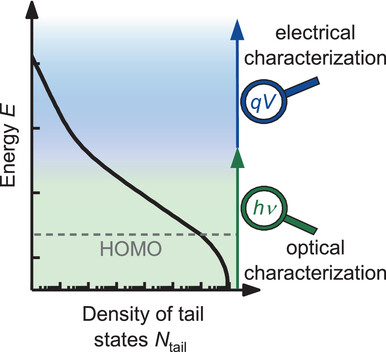Hartnagel, P., Ravishankar, S., Klingebiel, B., Thimm, O., Kirchartz, T.
Adv. Energy Mater. 2023, 13, 2300329
The energetic disorder has been known for decades to limit the performance of structurally disordered semiconductors such as amorphous silicon and organic semiconductors. However, in the past years, high-performance organic solar cells have emerged showing a continuously reduced amount of energetic disorder. While searching for future high-efficiency material systems, it is therefore important to correctly characterize this energetic disorder. While there are several techniques in the literature, the most common approaches to probe the density of defect states are using optical excitation as in external quantum efficiency measurements, or sequential filling of the tail states by applying an external voltage as in admittance spectroscopy. A metanalysis of available literature, as well as the experiments using four characterization techniques on two material systems, reveal that electrical, voltage-dependent measurements frequently yield higher values of energetic disorder than optical measurements. With drift-diffusion simulations, it is demonstrated that the approaches probe different energy ranges of the subband-gap density of states. The limitations of the techniques are further explored and it is found that extraction of information from a capacitance-voltage curve can be inhibited by internal series resistance. Thereby, the discrepancies between measurement techniques with sensitivity to different energy ranges and electronic parameters are explained.

Hartnagel, P., Ravishankar, S., Klingebiel, B., Thimm, O., Kirchartz, T.
Adv. Energy Mater. 2023, 13, 2300329
The energetic disorder has been known for decades to limit the performance of structurally disordered semiconductors such as amorphous silicon and organic semiconductors. However, in the past years, high-performance organic solar cells have emerged showing a continuously reduced amount of energetic disorder. While searching for future high-efficiency material systems, it is therefore important to correctly characterize this energetic disorder. While there are several techniques in the literature, the most common approaches to probe the density of defect states are using optical excitation as in external quantum efficiency measurements, or sequential filling of the tail states by applying an external voltage as in admittance spectroscopy. A metanalysis of available literature, as well as the experiments using four characterization techniques on two material systems, reveal that electrical, voltage-dependent measurements frequently yield higher values of energetic disorder than optical measurements. With drift-diffusion simulations, it is demonstrated that the approaches probe different energy ranges of the subband-gap density of states. The limitations of the techniques are further explored and it is found that extraction of information from a capacitance-voltage curve can be inhibited by internal series resistance. Thereby, the discrepancies between measurement techniques with sensitivity to different energy ranges and electronic parameters are explained.